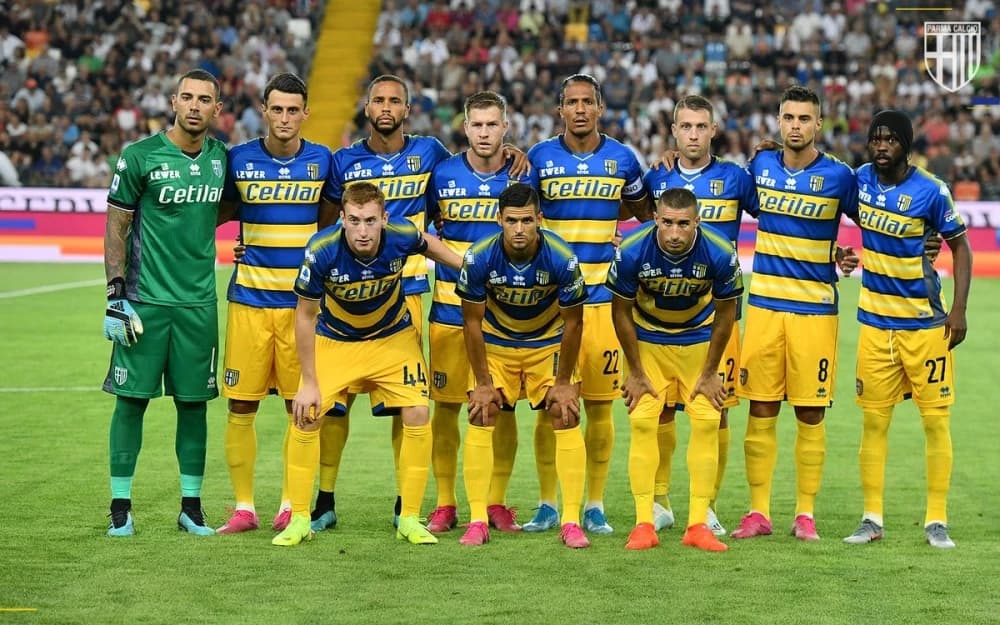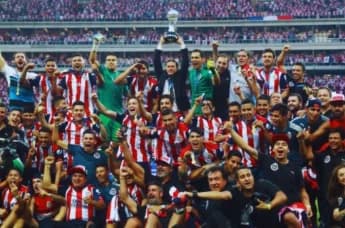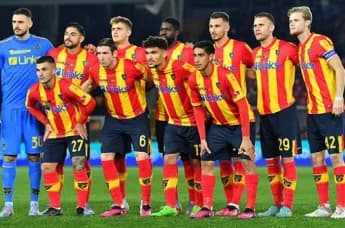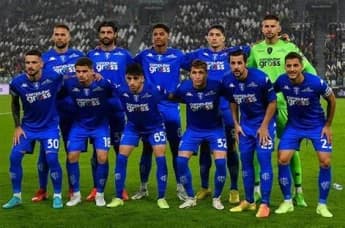Parma Calcio 1913 embodies the spirit of perseverance and dedication in Italian football, boasting a glorious history, numerous trophies, and a commitment to a bright future.
Parma Calcio 1913, located in the charming city of Parma in Emilia-Romagna, has been a fundamental part of Italian football since its establishment in 1913. Originally called Verdi Foot Ball Club, the team embraced its identity with yellow and blue colors, honoring the city’s rich cultural legacy, including the renowned opera composer Giuseppe Verdi.
The club transitioned to Parma Foot Ball Club later in 1913, adopting the distinctive white kits adorned with a black cross. Throughout the years, Parma has become emblematic of resilience, navigating through periods of both success and difficulty. Their venue, the Stadio Ennio Tardini, has served as a reliable backdrop since 1923, representing stability in the face of change.
The culture of Parma is deeply rooted in resilience, with a devoted fanbase that remains steadfast during financial hardships and relegations. The history of the team showcases a combination of regional pride and global ambitions, making it one of the most cherished clubs in Italy.
In spite of various challenges, Parma has managed to maintain its resilient spirit, reflecting the city’s values of hard work and determination. Evolving from modest origins to reclaiming its place in Serie A, the club continues to symbolize hope and perseverance.
Accomplishments of the Team
The golden age of Parma, spanning from 1992 to 2002, is regarded as a significant high point in Italian football history. With the financial backing of Calisto Tanzi, the club secured eight major honors, which included three Coppa Italia trophies and two UEFA Cups. Additionally, this era marked their highest Serie A placement, finishing as runners-up in the 1996–97 season.
In European competitions, Parma secured esteemed titles, including the UEFA Cup Winners' Cup and the European Super Cup, demonstrating their capacity to compete among the continent's best teams. These accomplishments enhanced their reputation as a formidable presence on the international football stage.
Parma's remarkable achievement of securing three consecutive promotions from Serie D to Serie A following their bankruptcy in 2015 highlighted their unyielding spirit. This accomplishment not only showcased their resilience but also established a record in the annals of Italian football.
The club’s legacy is further emphasized by its involvement in European competitions and its ability to develop talents such as Gianluigi Buffon and Hernán Crespo, who both became legends in the sport.
Strengths and Limitations
The strength of Parma lies in its profound bond with the local community and a dedicated fanbase that stands by the team in both good times and bad. The club has demonstrated an admirable ability to recover from challenges, highlighting its commitment to teamwork and unwavering resolve.
The club's infrastructure, particularly the iconic Stadio Ennio Tardini, offers a strong foundation for success. Furthermore, Parma has a rich tradition of developing skilled players through its youth academy, ensuring a steady stream of talented individuals. Their recent promotion to Serie A underscores their resurgence in competitiveness.
Parma has frequently encountered financial instability, with poor management resulting in times of downturn. The process of rebuilding following bankruptcy has proven to be difficult, with constrained resources hindering their capacity to recruit high-caliber talent.
The team has experienced fluctuations in its performances, struggling to establish a solid presence in Serie A. Concerns have emerged regarding defensive weaknesses and insufficient squad depth in recent seasons. Tackling these challenges will be vital for achieving long-term success.
Tactics & Playing Style
Over the years, Parma's tactical approach has transformed, integrating traditional Italian defensive discipline with an exciting style of attacking football. Their focus on teamwork and well-organized defensive structures has consistently been a defining feature of their play.
During the 1990s, Parma gained a reputation for its practical and effective style of play, particularly strong in set pieces and counterattacks. Players like Crespo and Enrico Chiesa flourished in a system that successfully combined creativity with efficiency.
With the current management, Parma is striving to meet the challenges of contemporary football by incorporating a style that emphasizes possession and rapid transitions. The focus continues to be on exploiting the wings and leveraging the technical abilities of their attacking players.
The team's ability to adapt to the tactics of their opponents has been a significant aspect of their play, allowing them to remain competitive even against more formidable teams. Striking a balance between tradition and innovation will be crucial as they face the challenges in Serie A.
Memorable Matches
1993 UEFA Cup Final: Parma achieved a 3-1 aggregate win against Royal Antwerp, earning their first European trophy and signifying their emergence on the international football scene.
1995 UEFA Cup Winners’ Cup Final: In a display of tactical excellence and strong defensive fundamentals, Parma secured a 1-0 victory over Arsenal in Copenhagen.
1999 UEFA Cup Final: A decisive 3-0 win against Olympique de Marseille showcased Parma’s superiority during their golden era.
2015 Serie D Promotion: Following their bankruptcy, the club embarked on a remarkable journey back to professional football, starting with a record-breaking season in Serie D that rekindled hope among their supporters.
Prospects for the Future
Parma is currently focused on reinforcing their position in Serie A after their promotion in 2023. It will be crucial to enhance the team through strategic player acquisitions and by nurturing young talent to ensure long-term success.
Ensuring financial stability continues to be a key focus, with initiatives aimed at attracting investments and maximizing revenue sources. Improving facilities, such as updating the Stadio Ennio Tardini, will boost fan involvement and enhance the overall matchday experience.
The club seeks to regain its former glory in European competition by steadily assembling a competitive squad. Achieving consistent performances and adopting innovative tactics in football are essential components of their strategy moving forward.
With a solid foundation in place, Parma is ready to restore its reputation as a powerful entity in Italian football, reflecting the tenacity and fervor that characterize its identity.
Parma Calcio 1913, located in the charming city of Parma in Emilia-Romagna, has been a fundamental part of Italian football since its establishment in 1913. Originally called Verdi Foot Ball Club, the team embraced its identity with yellow and blue colors, honoring the city’s rich cultural legacy, including the renowned opera composer Giuseppe Verdi.
The club transitioned to Parma Foot Ball Club later in 1913, adopting the distinctive white kits adorned with a black cross. Throughout the years, Parma has become emblematic of resilience, navigating through periods of both success and difficulty. Their venue, the Stadio Ennio Tardini, has served as a reliable backdrop since 1923, representing stability in the face of change.
The culture of Parma is deeply rooted in resilience, with a devoted fanbase that remains steadfast during financial hardships and relegations. The history of the team showcases a combination of regional pride and global ambitions, making it one of the most cherished clubs in Italy.
In spite of various challenges, Parma has managed to maintain its resilient spirit, reflecting the city’s values of hard work and determination. Evolving from modest origins to reclaiming its place in Serie A, the club continues to symbolize hope and perseverance.
Accomplishments of the Team
The golden age of Parma, spanning from 1992 to 2002, is regarded as a significant high point in Italian football history. With the financial backing of Calisto Tanzi, the club secured eight major honors, which included three Coppa Italia trophies and two UEFA Cups. Additionally, this era marked their highest Serie A placement, finishing as runners-up in the 1996–97 season.
In European competitions, Parma secured esteemed titles, including the UEFA Cup Winners' Cup and the European Super Cup, demonstrating their capacity to compete among the continent's best teams. These accomplishments enhanced their reputation as a formidable presence on the international football stage.
Parma's remarkable achievement of securing three consecutive promotions from Serie D to Serie A following their bankruptcy in 2015 highlighted their unyielding spirit. This accomplishment not only showcased their resilience but also established a record in the annals of Italian football.
The club’s legacy is further emphasized by its involvement in European competitions and its ability to develop talents such as Gianluigi Buffon and Hernán Crespo, who both became legends in the sport.
Strengths and Limitations
The strength of Parma lies in its profound bond with the local community and a dedicated fanbase that stands by the team in both good times and bad. The club has demonstrated an admirable ability to recover from challenges, highlighting its commitment to teamwork and unwavering resolve.
The club's infrastructure, particularly the iconic Stadio Ennio Tardini, offers a strong foundation for success. Furthermore, Parma has a rich tradition of developing skilled players through its youth academy, ensuring a steady stream of talented individuals. Their recent promotion to Serie A underscores their resurgence in competitiveness.
Parma has frequently encountered financial instability, with poor management resulting in times of downturn. The process of rebuilding following bankruptcy has proven to be difficult, with constrained resources hindering their capacity to recruit high-caliber talent.
The team has experienced fluctuations in its performances, struggling to establish a solid presence in Serie A. Concerns have emerged regarding defensive weaknesses and insufficient squad depth in recent seasons. Tackling these challenges will be vital for achieving long-term success.
Tactics & Playing Style
Over the years, Parma's tactical approach has transformed, integrating traditional Italian defensive discipline with an exciting style of attacking football. Their focus on teamwork and well-organized defensive structures has consistently been a defining feature of their play.
During the 1990s, Parma gained a reputation for its practical and effective style of play, particularly strong in set pieces and counterattacks. Players like Crespo and Enrico Chiesa flourished in a system that successfully combined creativity with efficiency.
With the current management, Parma is striving to meet the challenges of contemporary football by incorporating a style that emphasizes possession and rapid transitions. The focus continues to be on exploiting the wings and leveraging the technical abilities of their attacking players.
The team's ability to adapt to the tactics of their opponents has been a significant aspect of their play, allowing them to remain competitive even against more formidable teams. Striking a balance between tradition and innovation will be crucial as they face the challenges in Serie A.
Memorable Matches
1993 UEFA Cup Final: Parma achieved a 3-1 aggregate win against Royal Antwerp, earning their first European trophy and signifying their emergence on the international football scene.
1995 UEFA Cup Winners’ Cup Final: In a display of tactical excellence and strong defensive fundamentals, Parma secured a 1-0 victory over Arsenal in Copenhagen.
1999 UEFA Cup Final: A decisive 3-0 win against Olympique de Marseille showcased Parma’s superiority during their golden era.
2015 Serie D Promotion: Following their bankruptcy, the club embarked on a remarkable journey back to professional football, starting with a record-breaking season in Serie D that rekindled hope among their supporters.
Prospects for the Future
Parma is currently focused on reinforcing their position in Serie A after their promotion in 2023. It will be crucial to enhance the team through strategic player acquisitions and by nurturing young talent to ensure long-term success.
Ensuring financial stability continues to be a key focus, with initiatives aimed at attracting investments and maximizing revenue sources. Improving facilities, such as updating the Stadio Ennio Tardini, will boost fan involvement and enhance the overall matchday experience.
The club seeks to regain its former glory in European competition by steadily assembling a competitive squad. Achieving consistent performances and adopting innovative tactics in football are essential components of their strategy moving forward.
With a solid foundation in place, Parma is ready to restore its reputation as a powerful entity in Italian football, reflecting the tenacity and fervor that characterize its identity.







